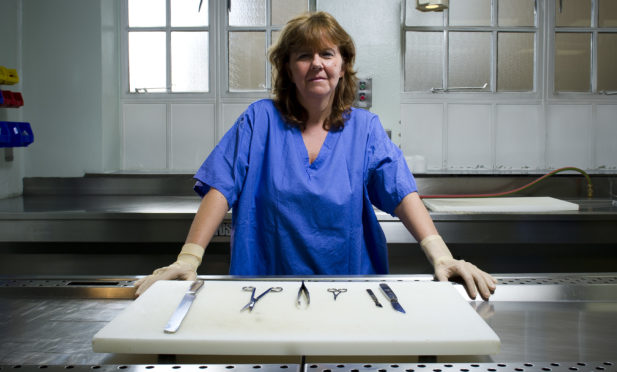
With every day and every body, Marjorie Turner sees the human cost of Scotland’s escalating drugs crisis.
At the mortuary suite at Glasgow’s Queen Elizabeth University Hospital, the leading forensic pathologist performs post-mortem examinations on up to 20 overdose victims every week.
Last week we revealed how more women were dying because of drugs in Scotland as experts called for more specialist care and support for addicts.
The rising number of female victims is confirmed by Dr Turner, who describes how overdose is claiming lives of people of every age and social class.
When someone suspected of dying of a drugs overdose is brought into the mortuary, they are taken to one of two specialist examination rooms, where an exhaustive investigation begins to establish what killed them.
Dr Turner, a consultant forensic pathologist, says her examinations in recent years have increasingly discovered two substances said to be driving Scotland’s escalating drug toll, with official figures expected to reveal up to 1,200 deaths last year alone.
One is a street drug called etizolam, a benzodiazepine-like fake Valium, while drugs containing fentanyl, an opioid pain medication, are also found in an increasing number of victims. Opioids can switch off the breathing part of the brain.
On Monday, UK Health Secretary Matt Hancock announced all opioid medicines, including fentanyl, will carry more prominent health warnings after a huge rise in prescriptions over the past 10 years.
A spokesman for the Medicines and Healthcare Products Regulatory Agency (MHRA) confirmed that all medicines containing opioids will have will have warnings before the end of this year.
In Scotland, codeine-related deaths spiked at 43 in 2016, dropping to 27 in 2017, according to National Records of Scotland, but that figure is expected to rise when the 2018 figures are released.
Last month, figures revealed a 43% rise in the number of drugs deaths from January to October last year, compared to 2017.
“It’s a worrying rise by anyone’s standards,” said Dr Turner.
“We carry out up to 20 post-mortems on those who have suffered drug deaths every week.
“The victims have usually taken a mix of drugs and possibly alcohol in addition to the etizolam and fentanyl that we have seen the significant rise in recently.
“They come from all spectrums of life, from those who have been blighted by homelessness and poverty to comfortable people whose lifestyles would outwardly suggest a happy life.
“Few of them will have taken the drugs thinking they were ending their lives.”
Meticulous post-mortem examination of tissue with high-resolution microscopes can tease out the truth where causes of death border on natural reasons and others causes involving drug overdose.
“We examine the slides and follow the investigation through to pinpointing the exact cause of death,” Dr Turner added.
“At best we can do the forensic pathology which gives families the answers as to why their loved ones died. The causes of death also help chart what is currently being traded by dealers on our streets.”
The pathology team have seen changes in the victims they examine.
“The average age of overdoses of street drugs used to be 20 to 30,” said Dr Turner.
“Today they are older and middle-aged or approaching it, sometimes people who have been using drugs for 10 or 20 years and who eventually die from them.
“Having survived for so long has perhaps given them a false sense of security, or they have been unable to come off drugs.
“Anything bought illicitly comes with no guarantee of what’s in it.
“They take what’s available and, sadly, that’s killing them.
“They are people’s sons, brothers, fathers, mothers, daughters…people who are loved and missed.
“Sometimes people will take a drug and then die from say a heart attack or sepsis.
“Close examination also determines whether the person has been murdered.
“Looking at tissue down the microscope can tell us what killed the person.
“What seems to be a straightforward drugs overdose can be something else.
“Accuracy in post-mortems is hugely important.”
Most pathologists never meet the victim’s family, not unless they have specific questions to ask about why their loved one died.
By far the highest number of deaths happen in Greater Glasgow and Clyde, which accounts for 30%.
Lothian suffers half that at 15%, closely followed by Lanarkshire at 11% and Tayside with 10%.

Enjoy the convenience of having The Sunday Post delivered as a digital ePaper straight to your smartphone, tablet or computer.
Subscribe for only £5.49 a month and enjoy all the benefits of the printed paper as a digital replica.
Subscribe